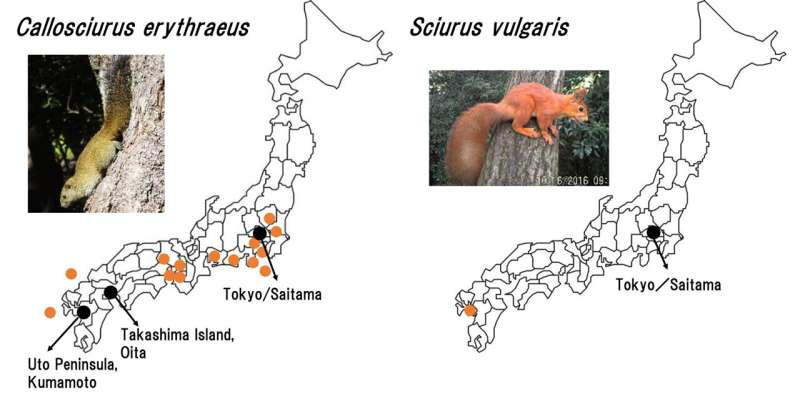This article has been reviewed according to Science X's editorial process and policies. Editors have highlighted the following attributes while ensuring the content's credibility:
fact-checked
peer-reviewed publication
proofread
Close encounters of the furry kind: Managing alien squirrel invasion in Japan

Japan is home to at least three different native sciurine species—squirrels, as we commonly call them—including the Japanese squirrel, the Japanese flying squirrel, and the Japanese giant flying squirrel. In recent time, owing to the intentional and accidental introduction of non-native squirrels, the nationwide distribution of Japan's native squirrels has shown a general trend of decline.
There is a need for concentrated effort to address this growing ecological problem. However, most articles highlighting this issue are written in Japanese, which may hinder collaborative engagement of a wider pool of researchers, conservationists, and policymakers.
Therefore, researchers Dr. Noriko Tamura and Dr. Masatoshi Yasuda from Japan's Forestry and Forest Products Research Institute (FFPRI) have recently published a review on this topic in English to highlight their eradication-related accomplishments and aid similar eradication in other parts of the world. This paper has been published in Frontiers in Ecology and Evolution.
Elaborating on the necessity of their study, Dr. Tamura says, "Prior studies confirm the introduction of three species of alien squirrels in Japan: Tamias sibiricus, Callosciurus erythraeus, including the species complex Callosciurus finlaysonii, and Sciurus vulgaris. Japan is home to the endemic squirrel species Sciurus lis, Petaurista leucogenys, and Pteromys momonga in Honshu, Shikoku, and Kyushu, as well as to the endemic subspecies Sciurus vulgaris orientis, Tamias sibiricus lineatus, and Pteromys volans orii in Hokkaido. At this point, we need to address the ecosystem damage caused by the alien species and also focus on conserving the endemic Japanese species."
The alien invasion has historic origins. For instance, Pallas's squirrels (Callosciurus erythraeus) got accidentally introduced in Japan after a typhoon destroyed their breeding cages in the 1930s and also after they escaped from a Gifu City exposition in 1936. However, their population increase may also be attributed to the commercial interests of the Japanese tourism industry and to Japanese citizens who became familiar with the squirrels after visiting tourist parks based in foreign countries.
Masatoshi Yasuda from FFPRI, the coauthor of the study, says, "The Japanese squirrel, Sciurus lis, has not been observed in Kyushu for the past 100 years and is likely extinct. In 14 prefectures, especially in western Honshu, the Japanese squirrel has only a small distribution area and even if it is present, its density is extremely low, so it is designated as a regionally endangered species. The Japanese flying squirrel, Pteromys momonga, is considered endangered in most of Japan's prefectures. The Japanese giant flying squirrel, Petaurista leucogenys, is also categorized as a regionally endangered species in Kyushu."
The problem gets further confounded by the fact that neither Japan's citizens nor its government-appointed officials can easily distinguish between non-native and native sciurine species. Moreover, both entities are significantly unaware of the damage that alien squirrels cause to ecosystems, agriculture, and forestry.
To mitigate the effects of the nationwide alien squirrel invasion, researchers, including the authors of this review, stepped in to share technical advice and initiate action plans. To this end, the participating damage control teams used physical trapping methods and, in some cases, additional chemical control methods.
As part of an initial eradication program, cage traps were fastened on trees and baited with attractants such as chestnuts and peanuts. The captured squirrels were euthanized with an overdose of carbon dioxide in accordance with the guidelines issued by the Japanese government. In some areas, an incentive of 800 yen per animal was announced for promoting the capture of alien squirrels in the early stages with high density.
At the moment, the eradication program includes modern control systems and improved trapping regimes. Consequently, the alien squirrel density is seeing a significant decrease, particularly if the population is at an early stage of up to 5000 individuals.
Citizens—by understanding the importance of prevention—and administrators—by seeking help from trained experts—can play key roles in the eradication program. The authors conclude on a positive note by stating that eradication efforts have been successful in four Japanese locations because of the active involvement of experts and other concerned stakeholders.
In summary, this article shows that early action against invading alien species is absolutely critical for ensuring ecological balance and conserving rare endemic species.
More information: Noriko Tamura et al, Distribution and management of non-native squirrels in Japan, Frontiers in Ecology and Evolution (2023). DOI: 10.3389/fevo.2022.1061115
Journal information: Frontiers in Ecology and Evolution
Provided by Forestry and Forest Products Research Institute

















